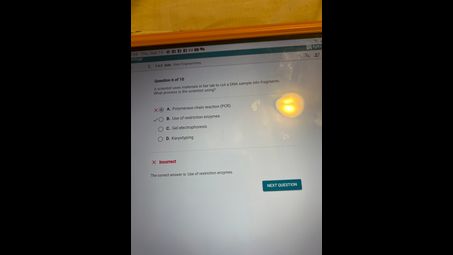A scientist uses material in her lab to separate dna fragments by size .what process is she using?
PCR or polymerase chain reaction. :: Apex
The scientist is using a technique called gel electrophoresis to separate DNA fragments by size. This process involves running an electric current through a gel matrix, causing DNA fragments to migrate based on their size, with smaller fragments moving faster and traveling further in the gel.
Add your answer:
What are ossified fragments?
Ossified fragments are fragments of bone that have turned into solid tissue through the process of calcification. This occurs when bone or cartilage undergoes a process of ossification, becoming hardened and less flexible. Ossified fragments can be a result of injury, trauma, or disease.
Explain how an agarose gel can separate DNA fragments of different lengths.?
In an agarose gel electrophoresis, smaller DNA fragments move faster through the gel matrix than larger fragments due to their size and charge. When an electric field is applied, DNA fragments are pulled through the gel towards the positive electrode, allowing separation based on size. The smaller fragments can navigate through the pores of the gel more easily, resulting in distinct bands corresponding to different lengths of DNA fragments after staining.
What does Taping the DNA onto large paper simulate?
Taping DNA onto large paper simulates DNA electrophoresis, a process used to separate and visualize DNA fragments based on size. By laying out the DNA fragments in a straight line, it allows for easier analysis and comparison of different DNA samples.
What is the process of adding fragments of DNA to other DNA called?
The process of adding fragments of DNA to other DNA is called DNA ligation. This involves joining together two DNA fragments using an enzyme called DNA ligase, which helps to form a covalent bond between the DNA fragments.
What is the process by which scientist grade the process by which scientists before it is published?
yes
Can electrolysis be used to separate DNA fragments?
No, electrolysis is not typically used to separate DNA fragments. DNA separation techniques such as gel electrophoresis are more commonly used in molecular biology to separate DNA fragments based on size. Electrolysis is a process that uses an electric current to drive a chemical reaction.
What is used to separate DNA fragments by size?
Electrophoresis. Restriction enzymes are used to cut DNA into fragments. Solutions containing these fragments are placed on the surface of a gel to which an electric current is applied. The electric current causes the DNA fragments to move through the gel. Because smaller fragments move more quickly than larger ones, this process separates the fragments according to size.
Gel electrophorysis and GMO food?
Gel electrophoresis is a method for separation and analysis of macromolecules (DNA, RNA and proteins) and their fragments, based on their size and charge.The tool of DNA gel electrophoresis was developed in the 1970s. The process uses electricity to separate DNA fragments by size as they migrate through a gel matrix.It can be used to separate proteins that are used in genetically modified foods.
What are ossified fragments?
Ossified fragments are fragments of bone that have turned into solid tissue through the process of calcification. This occurs when bone or cartilage undergoes a process of ossification, becoming hardened and less flexible. Ossified fragments can be a result of injury, trauma, or disease.
Explain how an agarose gel can separate DNA fragments of different lengths.?
In an agarose gel electrophoresis, smaller DNA fragments move faster through the gel matrix than larger fragments due to their size and charge. When an electric field is applied, DNA fragments are pulled through the gel towards the positive electrode, allowing separation based on size. The smaller fragments can navigate through the pores of the gel more easily, resulting in distinct bands corresponding to different lengths of DNA fragments after staining.
What is the process for using heat to separate gold from rock called?
The process of using heat to separate gold from rock is called smelting. During smelting, the rock containing gold is heated at high temperatures to melt the gold, allowing it to separate from the surrounding rock material.
What process breaks fragments from a mountain side?
Erossion.
Which features of DNA fragments are used to separate them in the process of gel electrophoresis?
DNA fragments are separated based on their size. Shorter fragments move faster through the gel, while larger fragments move slower. This size-dependent separation allows scientists to visualize and analyze the DNA fragments accurately.
What does Taping the DNA onto large paper simulate?
Taping DNA onto large paper simulates DNA electrophoresis, a process used to separate and visualize DNA fragments based on size. By laying out the DNA fragments in a straight line, it allows for easier analysis and comparison of different DNA samples.
What is the process of adding fragments of DNA to other DNA called?
The process of adding fragments of DNA to other DNA is called DNA ligation. This involves joining together two DNA fragments using an enzyme called DNA ligase, which helps to form a covalent bond between the DNA fragments.
Why does extracted DNA need to be fragmented?
In preparation for the electrophoresis step in "DNA fingerprinting" the electrophoresis process cannot separate meaningfully massive molecules like whole chromosomes. By using restriction enzymes that break the chromosomes at known places DNA fragments of a wide variety of lengths that the electrophoresis process can separate meaningfully will allow a pattern to be generated that can identify different individuals.
Process generating sticky lipid fragments that increase atherosclerosis?
digestion

